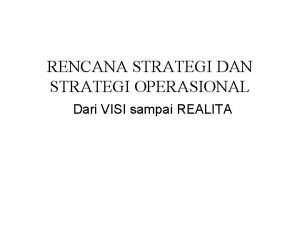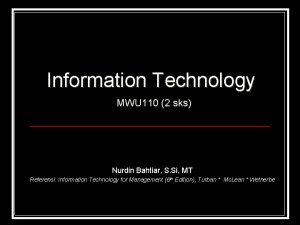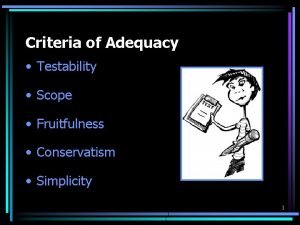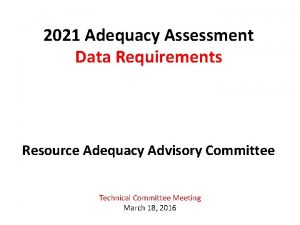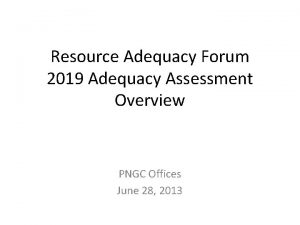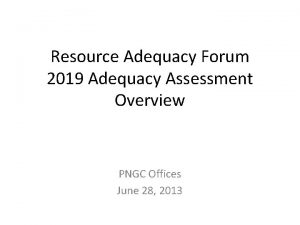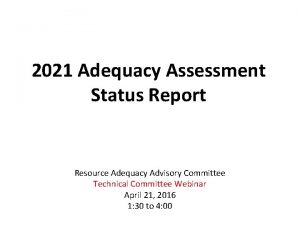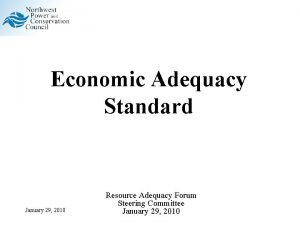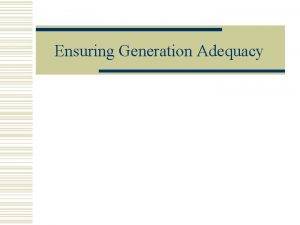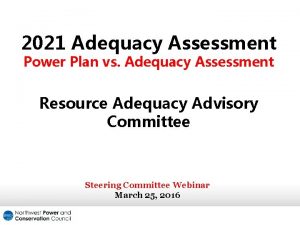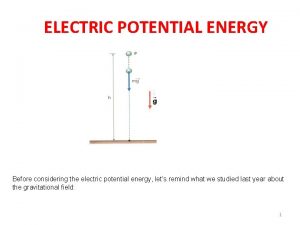Electric Resource Adequacy Considering Other Critical Success Factors










- Slides: 10

Electric Resource Adequacy – Considering “Other” Critical Success Factors besides Capacity Market Design Susan Tierney – Presentation to Massachusetts Restructuring Roundtable March 18, 2005 BOSTON DALLAS DENVER LOS ANGELES MENLO PARK MONTREAL NEW YORK SAN FRANCISCO WASHINGTON

Context for my remarks n Paul Joskow, MIT – resource adequacy from economist’s point of view n Dave La. Plante, ISO-NE – resource adequacy from NE’s point of view n My remarks – critical success factors for assuring resource adequacy n Next panel – LICAP: Promises and Potential Pitfalls – Stoft, Daly (NStar), Corneli (NRG), Austin (Maine) 2

“Critical Success Factors” for Resource Adequacy What factors are necessary for its success? n Entry issues – siting the infrastructure n The demand side – activating this market n State preferences – aligning them with markets n Federal/state tensions – keeping them at bay n Market monitoring – enabling markets, curbing abuses 3

Ease of entry: G & T Planning and Siting Can “required” capacity get needed approvals? n State reviews of facility proposals: n Tensions over markets versus administrative analyses in determining “need”? n Valuing out-of-state needs in state reviews? n Aligning siting reviews with signals set by other policies and processes (e. g. , LICAP, RTEP, RFP)? n Using “need” analysis to constrain entry? n Tussles over federal preemption and states rights? n Convergence of gas facility projects with electric market requirements and siting tensions? 4

The Demand Side: Activating this market Capacity markets (bilateral, spot) work best with a viable demand side: n Demand supplies are both needed: n n n Non-vertical demand curve (e. g. , willingness to pay) Capacity on call (e. g. , load shedding for pay) Critical success factors for enabling demand markets: n n n Comparable compensation for comparable resources? Bilateral (e. g. , contractual) and spot market resources? Impact of “free calls” on demand-side capacity (except in dire emergencies)? 5

State resource preferences – Aligning with regional markets Policy directives for resource “preferences” n Various state policies/preferences affect resource decisions and portfolios, e. g. , n n n n n Procurement procurements (e. g. , forward contracts) Content requirements (e. g. , RPS) Emissions markets (e. g. , carbon (RGGI)) Ownership requirements (e. g. , divestiture, no build) Moratoria (e. g. , underwater T, wind, LNG) Retail pricing and metering policies (e. g. , time of use) Reliability standards (e. g. , < or > reg’l MW standard) “least-cost” reviews (e. g. , all resource comparisons) Consider whether and how best to align design/ administration of such policies with resource adequacy approaches 6

Federal/states tensions on policy – keeping tensions at bay Traditional state role in utility cost-recovery n Reviewing utility’s power purchases/ investments to determine what/how to include in retail rates: n n n Prudent, used and useful investments (G and T). Prudent power purchases, demand-side and DG actions Recent federal/state tensions – example: n n Who has rights to transmission capacity embedded in retail rates? Who decides whether an asset should or may be acquired by a utility (e. g. , FERC’s “safety net” concerns (Cinergy)), or whether to approve affiliate transactions arising from statesupervised utility actions (e, g. , Allegheny) What actions (e. g. , change in resource status) triggers FERC reporting by holders of market-based wholesale rate authority? Implications of NARUC resolution on resource adequacy, FERC and the states? 7

Marketing monitoring: Enabling markets, curbing abuses The structure of market design (including capacity markets) intersects with MM/M n If capacity markets are properly structured, there may be less need for certain types of MM/M measures, and vice versa. n Types of structural market design elements that can affect MM/M n n n Forward contracting amounts, requirements Design of any mechanism for true-ing up revenues in capacity market Viability of the demand response function 8

Summary thoughts Resource Adequacy Policy is more than just the RTO’s Capacity Mechanism n Resource adequacy costs are long-standing element of provision of retail service (included in rates) n While RTO policy is critical element in assuring adequate resources, so are other factors: n n n Allowing timely infrastructure siting focused on env’l and site-specific issues Ensuring an active demand-side market Aligning any state policy preferences with markets Keeping federal/state relationships constructive Aligning market monitoring with market structure 9

Susan F. Tierney, Ph. D. Managing Principal Analysis Group, Inc. 111 Huntington Ave. , 10 th Floor Boston, MA 02199 ph: 617 -425 -8114 fax: 617 -425 -8001 stierney@analysisgroup. com www. analysisgroup. com 10
 Critical semi critical and non critical instruments
Critical semi critical and non critical instruments Semi critical
Semi critical Your child's success or lack of success
Your child's success or lack of success Your child's success or lack of success
Your child's success or lack of success Space matrix
Space matrix Contoh critical success factor
Contoh critical success factor Contoh critical success factor
Contoh critical success factor Software unit test coverage and adequacy
Software unit test coverage and adequacy Adequacy of test items in testing
Adequacy of test items in testing Criteria of adequacy fruitfulness
Criteria of adequacy fruitfulness Horizontal and vertical adequacy
Horizontal and vertical adequacy




